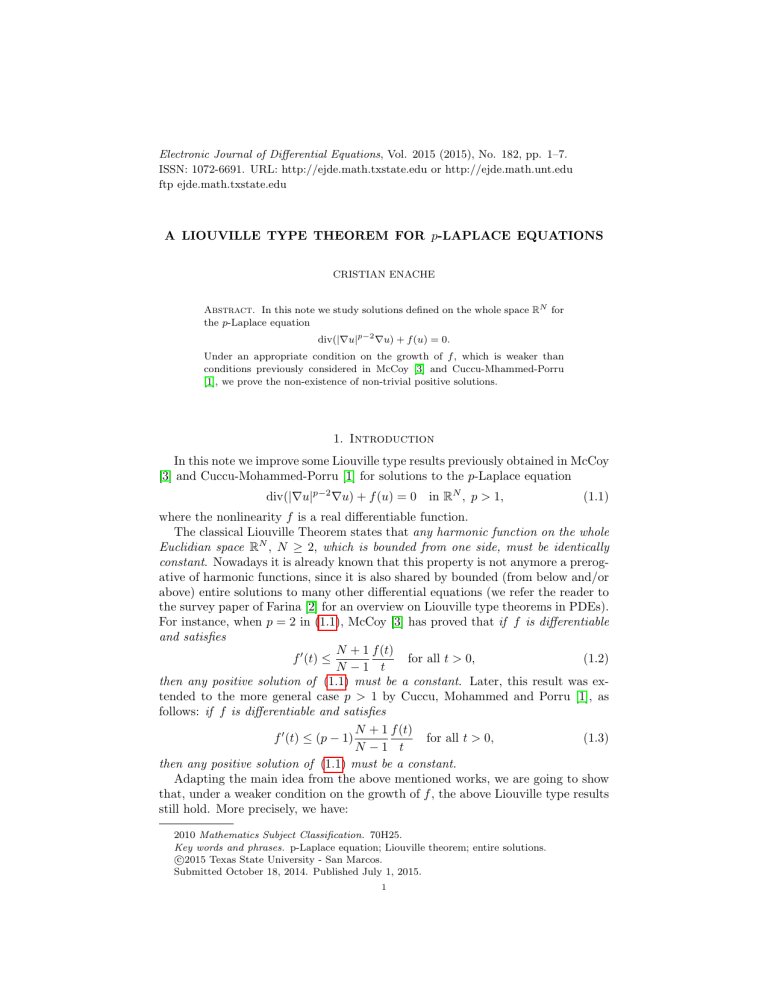Electronic Journal of Differential Equations, Vol. 2015 (2015), No. 182,... ISSN: 1072-6691. URL: or
advertisement

Electronic Journal of Differential Equations, Vol. 2015 (2015), No. 182, pp. 1–7.
ISSN: 1072-6691. URL: http://ejde.math.txstate.edu or http://ejde.math.unt.edu
ftp ejde.math.txstate.edu
A LIOUVILLE TYPE THEOREM FOR p-LAPLACE EQUATIONS
CRISTIAN ENACHE
Abstract. In this note we study solutions defined on the whole space RN for
the p-Laplace equation
div(|∇u|p−2 ∇u) + f (u) = 0.
Under an appropriate condition on the growth of f , which is weaker than
conditions previously considered in McCoy [3] and Cuccu-Mhammed-Porru
[1], we prove the non-existence of non-trivial positive solutions.
1. Introduction
In this note we improve some Liouville type results previously obtained in McCoy
[3] and Cuccu-Mohammed-Porru [1] for solutions to the p-Laplace equation
div(|∇u|p−2 ∇u) + f (u) = 0
in RN , p > 1,
(1.1)
where the nonlinearity f is a real differentiable function.
The classical Liouville Theorem states that any harmonic function on the whole
Euclidian space RN , N ≥ 2, which is bounded from one side, must be identically
constant. Nowadays it is already known that this property is not anymore a prerogative of harmonic functions, since it is also shared by bounded (from below and/or
above) entire solutions to many other differential equations (we refer the reader to
the survey paper of Farina [2] for an overview on Liouville type theorems in PDEs).
For instance, when p = 2 in (1.1), McCoy [3] has proved that if f is differentiable
and satisfies
N + 1 f (t)
f 0 (t) ≤
for all t > 0,
(1.2)
N −1 t
then any positive solution of (1.1) must be a constant. Later, this result was extended to the more general case p > 1 by Cuccu, Mohammed and Porru [1], as
follows: if f is differentiable and satisfies
N + 1 f (t)
for all t > 0,
(1.3)
f 0 (t) ≤ (p − 1)
N −1 t
then any positive solution of (1.1) must be a constant.
Adapting the main idea from the above mentioned works, we are going to show
that, under a weaker condition on the growth of f , the above Liouville type results
still hold. More precisely, we have:
2010 Mathematics Subject Classification. 70H25.
Key words and phrases. p-Laplace equation; Liouville theorem; entire solutions.
c 2015 Texas State University - San Marcos.
Submitted October 18, 2014. Published July 1, 2015.
1
2
C. ENACHE
EJDE-2015/182
Theorem 1.1. Assume that u(x) > 0 satisfies (1.1). If f is differentiable and
satisfies
N + 1 f (t)
f 0 (t) ≤ β(p − 1)
for all t > 0,
(1.4)
N −1 t
where
(
N −1
[1, N
−p ), when 1 < p < N,
β∈
(1.5)
[1, ∞),
when p ≥ N,
then u(x) must be a constant. As a consequence, if f (t) = 0 has no positive roots,
then (1.1) has no positive weak solutions.
2. Proof of Theorem 1.1
We first state a lemma which plays some role in the proof of Theorem 1.1.
Lemma 2.1 (Cuccu-Mohammed-Porru [1]). Let p > 1 be a real number and N ≥ 2.
If u(x) is a C 2 function and ui denotes partial differentiation with respect to xi ,
then
(p − 1)u211 +
N
X
i=2
u2ii ≥
2
1
(p − 1)(N − 1) + 1 2
u11 −
∆uu11 +
(∆u)2 . (2.1)
N −1
N −1
N −1
Let us now introduce the auxiliary function
P (u; x) :=
|∇u(x)|2
.
u2β (x)
(2.2)
Let us also consider a point x∗ where |∇u| > 0. From a seminal work of Tolksdorf
[4] we know that u(x) is smooth in ω := {x ∈ Ω : |∇u|(x) > 0}. Therefore, we may
compute in ω, successively, the following derivatives:
2
2β
uik ui − 2β+1 |∇u|2 uk
(2.3)
u2β
u
2
2
4β
4β
Pkl = 2β uik uil + 2β uikl ui − 2β+1 uik ui ul − 2β+1 uil ui uk
u
u
u
u
(2.4)
2β
2β(2β + 1)
2
2
|∇u|
u
u
−
|∇u|
u
.
+
k
l
kl
u2β+2
u2β+1
Now, performing eventually a translation and/or rotation if necessary, we choose
the coordinate axes such that at x∗ we have
Pk =
|∇u| = u1
ui = 0
for i = 2, . . . , N.
(2.5)
Using (2.5) in (2.4) we find that
2
2
8β
u1i u1i + 2β u111 u1 − 2β+1 u11 u21
2β
u
u
u
2β(2β + 1) 4
2β
+
u1 − 2β+1 u11 u21 ,
u2β+2
u
(2.6)
2
2
8β
uik uik + 2β (∆u)1 u1 − 2β+1 u11 u21
2β
u
u
u
2β(2β + 1) 4
2β 2
+
u1 − 2β+1 u1 ∆u.
u2β+2
u
(2.7)
P11 =
respectively
∆P =
EJDE-2015/182
A LIOUVILLE TYPE THEOREM
3
It then it follows that
∆P + (p − 2)P11
2
2
= 2β [(∆u)1 + (p − 2)u111 ]u1 + 2β [uik uik + (p − 2)u1j u1j ]
u
u
2β
2β(2β + 1)
2
− 2β+1 [∆u + (5p − 6)u11 ]u1 +
(p − 1)u41 .
u
u2β+2
(2.8)
On the other hand, differentiating (1.1) with respect to x1 and evaluating the result
making use of (2.5), we obtain that at x∗ we have
[(∆u)1 + (p − 2)u111 + 2(p − 2)
up−1
1
N
X
u21j u−1
1 ]
(2.9)
j=2
+ (p − 2)[∆u + (p −
2)u11 ]u11 u1p−3
+ f 0 u1 = 0.
Also, evaluating equation (1.1) at x∗ we have
∆u + (p − 2)u11 = −f (u)u2−p
.
1
(2.10)
Inserting (2.10) in (2.9) we obtain
(∆u)1 + (p − 2)u111 = 2(2 − p)
N
X
1−p
u21j u−1
− f 0 u3−p
.
1 + (p − 2)u11 f u1
1
(2.11)
j=2
Making now use of Lemma 2.1, we also have
uij uij + (p − 2)u1j u1j
≥ (p − 1)u211 +
N
X
u2ii + p
u21j
(2.12)
j=2
i=2
≥
N
X
N
X
1
2
(p − 1)(N − 1) + 1 2
u21j .
u11 −
∆uu11 +
(∆u)2 + p
N −1
N −1
N −1
j=2
Therefore, inserting (2.11) and (2.12) in (2.8) leads to
∆P + (p − 2)P11
≥
N
X
2 n
(4
−
p)
u21j + (p − 2)u11 f u2−p − f 0 u4−p
1
u2β
j=2
2
1
(p − 1)(N − 1) + 1 2
u11 −
∆uu11 +
(∆u)2
N −1
N −1
N −1
u2
u4 o
− β[∆u + (5p − 6)u11 ] 1 + β(2β + 1)(p − 1) 12 .
u
u
(2.13)
+
From (2.3) and (2.5) we have
Pi =
2
ui1 u1
u2β
for i = 2, . . . , N.
(2.14)
Therefore
N
N
X
4 2X
u
u
u
=
Pi2 ≤ |∇P |2 ,
i1
i1
1
u4β i=2
i=2
(2.15)
4
C. ENACHE
EJDE-2015/182
so that
N
X
2
|∇P |2
(4
−
p)
u21j ≥ −|4 − p|
.
2β
u
2P
j=2
(2.16)
Finally, since
(p − 1)(N − 1) + 1 + 2(p − 2) + (p − 2)2
(p − 1)(p + N − 2)
=
,
N −1
N −1
2
2(p − 2)
2(p − 1)
+
=
,
N −1
N −1
N −1
using (2.10) and (2.16) in (2.13) we are lead to
(2.17)
∆P + (p − 2)P11
|∇P |2
2 n
(p − 1)(p + N − 2) 2
+ 2β − f 0 u4−p
u11
+
1
2P
u
N −1
1
2(p − 1) 2−p
f u1 u11 +
(f u2−p
)2
+ p−2+
1
N −1
N −1
u2
u4 o
− β[4(p − 1)u11 − f u2−p
] 1 + β(2β + 1)(p − 1) 21 .
1
u
u
∗
Now, evaluating (2.3) at x , by using (2.5), we have
≥ −|4 − p|
P1 =
(2.18)
2
2β
u11 u1 − 2β+1 u31 ,
u2β
u
(2.19)
P1 u2β
u2
+ β 1.
2u1
u
(2.20)
so that
u11 =
Inserting (2.20) into (2.18) we obtain
∆P + (p − 2)P11
|∇P |2
2 n
+ 2β − f 0 u4−p
1
2P
u
(p − 1)(p + N − 2) P1 u2β
u2 2
+
+β 1
N −1
2u1
u
u2 2(p − 1) 2−p P1 u2β
f u1
+β 1
+ p−2+
N −1
2u1
u
h
P u2β
i 2
1
u21 1
2−p u1
2
(f u2−p
)
−
β
4(p
−
1)
+
+
β
−
f
u
1
1
N −1
2u1
u
u
4o
u1
+ β(2β + 1)(p − 1) 2 .
u
Next, using the restriction (1.4) on f we note that
f
2(p − 1) f 4−p
− f 0 u4−p + p − 2 +
β u1 + β u4−p
N −1
u
u 1
N +1f
= u4−p − f 0 + β(p − 1)
≥ 0.
N −1u
We also note that
(p − 1)(p + N − 2) P1 u2β 2
≥ 0.
N −1
2u1
≥ −|4 − p|
(2.21)
(2.22)
(2.23)
EJDE-2015/182
A LIOUVILLE TYPE THEOREM
5
Therefore
|∇P |2
2P
(p − 1)(p + N − 2) P1 u1
u41 +
2β
+ 2β 2 2β+2
N −1
u
u
(2.24)
2 (f u2−p
)2
2(p − 1)
1
+
P1 f u1−p
+ p−2+
1
N −1
N − 1 u2β
P1 u1
u41
− 4β(p − 1)
.
+ 2(p − 1)(β − 2β 2 ) 2β+2
u
u
Moreover, using the following two identities
2(p − 1)(p + N − 2)
2(p − 1)(p − N )
− 4(p − 1) =
,
(2.25)
N −1
N −1
p−1
2(p − 1)(p + N − 2) 2
β + 2(p − 1)(β − 2β 2 ) =
[2β 2 (p − N ) + 2β(N − 1)],
N −1
N −1
(2.26)
∆P + (p − 2)P11 ≥ −|4 − p|
one may easily see that (2.24) becomes
|∇P |2
(p − 1)(p − N ) P1 u1
∆P + (p − 2)P11
≥ −|4 − p|
+ 2β
P
2P 2
N −1
Pu
1−p
2(p − 1) P1 f u1
2
+ p−2+
+
(f u1−p
)2
1
N −1
P
N −1
p − 1 u21
.
+ 2β[β(p − N ) + N − 1]
N − 1 u2
Next, let us consider a point x0 ∈ RN and define
J(x) = (a2 − r2 )2 P,
(2.27)
(2.28)
where a > 0 is a constant and r := |x − x0 |. Let us denote by B the ball centered
at x0 and of radius a. Then we immediately notice that
J(x) ≥ 0 in B,
J(x) = 0 on ∂B.
(2.29)
∗
Consequently, J(x) must attain its maximum at some (interior) point x .
Now, if |∇u|(x∗ ) = 0, then P ≡ 0 in B. Since the ball was chosen arbitrarily,
P ≡ 0 in every ball, so that ∇u ≡ 0 in RN and our theorem follows. It thus
remain to analyze the case |∇u|(x∗ ) > 0. In such a case, we have the following
complementary inequality at x∗ (see Cuccu-Mohammed-Porru [1, p. 227] for the
proof; they used a different auxiliary function P , but the proof is identical, since
the form of P does not really play a role in the proof):
∆P + (p − 2)P11
Ca2
≤ 2
,
P
(a − r2 )2
C := 24 + 4N + 28|p − 2|.
(2.30)
Combining (2.27) and (2.30) we obtain
Ca2
|∇P |2
(p − 1)(p − N ) P1 u1
≥ −|4 − p|
+ 2β
2
2
2
−r )
2P
N −1
Pu
1−p
2(p − 1) P1 f u1
2
+ p−2+
+
(f u1−p
)2
1
N −1
P
N −1
p − 1 u21
+ 2β[β(p − N ) + N − 1]
.
N − 1 u2
(a2
(2.31)
6
C. ENACHE
EJDE-2015/182
On the other hand, differentiating (2.28) we obtain that at x∗ (the point of maximum for J in B) we have
Ji = −2(a2 − r2 )(r2 )i P + (a2 − r2 )2 Pi = 0,
(2.32)
so that
∇r2 P
(r2 )1 P
, ∇P = 2 2
.
2
2
a −r
a − r2
From (2.5) and (2.33) we then conclude that
P1 = 2
P1 u1
∇P ∇u
∇r2 ∇u
,
=
=2 2
P
P
a − r2
|∇P |
4r
2|∇(r2 )|
= 2
.
= 2
2
P
a −r
a − r2
Now using (2.34) and (2.35) in (2.31) we obtain
Ca2
8r2
(p − 1)(p − N ) ∇r2 ∇u
≥
−|4
−
p|
+
4β
(a2 − r2 )2
(a2 − r2 )2
N −1
(a2 − r2 )u
2
2(p − 1)
∇r ∇u
2
+2 p−2+
f u1−p
+
(f u1−p
)2
1
1
N −1
a2 − r2
N −1
p − 1 |∇u|2
.
+ 2β[β(p − N ) + N − 1]
N − 1 u2
Moreover, by classical inequalities we have
∇r2 ∇u
(a2 − r2 )u
|∇u|2
4r2
≥ −β 2 γ(p − 1)2 2 − 4(p − N )2
,
u
γ(a2 − r2 )2
(2.33)
(2.34)
(2.35)
(2.36)
4β(p − 1)(p − N )
(2.37)
and
2(p − 1) −p ∇r2 ∇u
f u1 2
N −1
a − r2
r
2(p − 1)
)|f |up−1
≥ −4(|p − 2| +
(2.38)
1
N −1
a2 − r2
2
r2
e
≥−
(f u1−p
,
)2 − C
1
2
N −1
(a − r2 )2
e := 2[(N − 1)(p − 2) + 2(p − 1)]2 /(N − 1). Inserting
with γ > 0 to be chosen and C
now estimates (2.37) and (2.38) into (2.36) we find
2(p − 2) +
8r2
4r2
r2
Ca2
2
e
≥
−|4
−
p|
−
4(p
−
N
)
−
C
(a2 − r2 )2
(a2 − r2 )2
γ(a2 − r2 )2
(a2 − r2 )2
p − 1 |∇u|2
+ [2β 2 (p − N ) + 2β(N − 1) − β 2 γ(p − 1)]
.
N − 1 u2
Now let us analyze separately the following two cases:
N −1
Case 1. when 1 < p < N and β ∈ [1, N
−p ), we have
2β 2 (p − N ) + 2β(N − 1) > 0.
(2.39)
(2.40)
Therefore, we can choose γ small enough so that we have
[2β 2 (p − N ) + 2β(N − 1) − β 2 γ(p − 1)] > 0.
smallskip
(2.41)
EJDE-2015/182
A LIOUVILLE TYPE THEOREM
7
Case 2. when p ≥ N and β ∈ [1, +∞), as above, we can again choose a small
enough γ so that (2.41) holds.
In conclusion, for a well chosen γ, there exists a constant K = K(N, p, β, γ) such
that
|∇u|2
Ka2
≤
.
(2.42)
u2
(a2 − r2 )2
Moreover, since u(x) is positive, there exists a constant L > 0 such that u2−2β ≤ L.
Therefore, at some point x∗ we have
|∇u|2 1
(a2 − r2 )2 ≤ KLa2 .
u2 u2β−2
But x∗ is a point of maximum for J(x) in B, so that we have
J(x∗ ) =
J(x0 ) =
|∇u|2 4
a ≤ KLa2 .
u2β
(2.43)
(2.44)
It follows that at x = x0 we have
|∇u|2
KL
≤ 2 .
(2.45)
u2β
a
Letting a → ∞ we find that ∇u = 0 at x0 . Since x0 is arbitrary, we must have
∇u = 0 in RN . The proof is thus achieved.
Acknowledgments. This work was supported by a CNCSIS (Romania) research
grant (PN-II-ID-PCE-2012-4-0021 : Variable Exponent Analysis: Partial Differential Equations and Calculus of Variations).
References
[1] F. Cuccu, A. Mohammed, G. Porru; Extensions of a theorem of Cauchy-Liouville, J. Math.
Anal. Appl., 369 (2011), 222–231.
[2] A. Farina; Liouville-type theorems for elliptic problems, Handbook of differential equations:
stationary partial differential equations, 4 (2007), 61–116.
[3] J. A. McCoy; Bernstein properties of solutions to some higher order equations, Diff. Int. Equ.,
20 (2007), 1153–1166.
[4] P. Tolksdorf; Regularity for a more general class of quasilinear elliptic equations, J. Differential
Equations, 51 (1984), 126–150.
Cristian Enache
Simion Stoilow Institute of Mathematics of the Romanian Academy, 010702,
Bucharest, Romania
E-mail address: cenache23@yahoo.com


